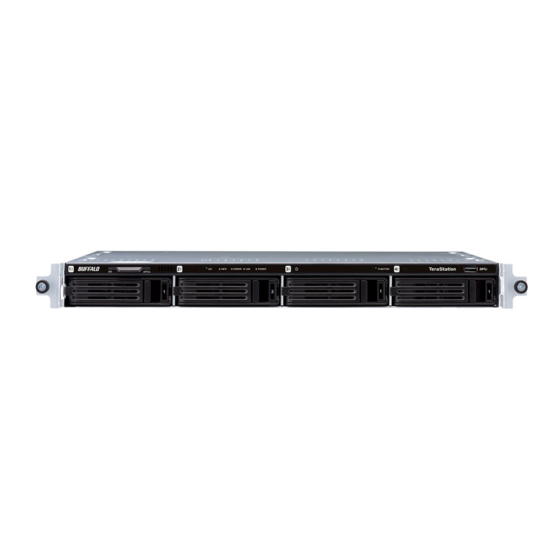
Summarization of Contents
Chapter 1 Getting Started
Diagrams
Visual representation of device components and ports for initial identification.
Turning the TeraStation On and Off
Procedures for powering the network storage device on and off safely.
Changing the Administrator Password
Steps to modify the default administrator password for enhanced security.
Chapter 2 Configuration
Opening Advanced Settings
Accessing the full web-based interface for comprehensive device management.
Opening Easy Admin
Accessing a simplified interface for frequently used configuration settings.
Chapter 3 Sharing Files
Configuring Shared Folders
Creating and managing shared folders for data access and organization.
Configuring Users
Setting up user accounts and managing their permissions for accessing shared data.
Adding a Group
Creating user groups to simplify permission management for shared resources.
Configuring Access Restrictions
Defining permissions for users and groups on specific shared folders.
Local Users and Groups
Managing user and group accounts directly on the TeraStation.
Active Directory
Integrating the TeraStation with an Active Directory domain for centralized user management.
NT Domain
Connecting the TeraStation to an NT domain for user authentication and access control.
Chapter 4 Managing Storage
RAID Modes
Understanding and configuring different RAID levels for data redundancy and performance.
Working with RAID Arrays
Procedures for managing existing RAID arrays, including using JBOD.
Adding an External Hard Drive
Connecting and utilizing external USB drives with the TeraStation for additional storage.
Dismounting Drives
Procedures for safely disconnecting internal and external storage drives.
Checking Drives
Running diagnostic checks on internal and external drives for integrity and errors.
Formatting Drives
Preparing drives for use by formatting them with supported file systems.
Encrypting Drives
Encrypting drives during formatting to protect data with AES encryption.
Erasing Data on the TeraStation Completely
Securely erasing all data and restoring the TeraStation to factory defaults.
Drive Quotas
Limiting storage space for users or groups to manage disk usage effectively.
Hard Drive Replacement
Step-by-step guide for replacing a failed hard drive and rebuilding the RAID array.
Chapter 6 Backup
Back Up from the TeraStation
Configuring the TeraStation to back up its own data to other locations.
Preparing a Backup Destination
Setting up a folder on the TeraStation or another device as a backup target.
Backing Up to a LinkStation or TeraStation on Another Network When Connected via VPN
Performing backups to remote devices over a VPN connection.
Configuring a Backup Job
Creating and scheduling automated backup tasks with various configuration options.
Chapter 7 Multimedia
DLNA
Enabling DLNA to share media files with compatible devices on the network.
Playing Files
Instructions on how to play media content from the TeraStation on DLNA devices.
Connected DLNA-compatible Devices
Viewing and managing DLNA devices connected to the TeraStation.
Streaming to DLNA-compatible Devices
Configuring media streaming from the TeraStation to DLNA-enabled devices.
Disabling Playback from Specific Devices
Blocking specific DLNA devices from accessing media content.
iTunes Server
Setting up the iTunes server to share music files with iTunes clients.
BitTorrent
Configuring and using the BitTorrent client for efficient data distribution.
Chapter 8 Advanced Features
Email Notification
Configuring email alerts for system events, errors, and status updates.
Sleep Mode
Setting schedules for the TeraStation to enter and exit sleep mode to save energy.
UPS (Uninterruptible Power Supply)
Connecting a UPS for automatic shutdown during power outages to protect data.
Connecting a Printer
Connecting and configuring a USB printer to be used with the TeraStation.
Offline Files
Enabling offline access to shared files for work when disconnected from the network.
Accessing from an NFS Client
Configuring and accessing shared folders using the NFS protocol from client systems.
Chapter 9 Utilities
NAS Navigator2 for Windows
Using the Windows utility to manage, configure, and monitor the TeraStation.
Mount as Network Drive
Mapping a shared folder as a network drive for easy access.
Changing the IP Address
Manually setting or changing the TeraStation's IP address.
NAS Navigator2 for Mac
Using the macOS utility to manage, configure, and monitor the TeraStation.
Mount as Network Drive
Mapping a shared folder as a network drive for easy access on macOS.
Changing the IP Address
Manually setting or changing the TeraStation's IP address via macOS utility.
NovaBACKUP
Installing and using NovaBACKUP software for data backup.
Installing from CD
Procedure for installing software from the included TeraNavigator CD.
Installing from Website
Procedure for downloading and installing software from the Buffalo website.
Chapter 10 Appendix
When the LED Blinks Red
Interpreting red LED blink patterns to diagnose hardware errors and their corrective actions.
When the LED Blinks Amber
Understanding amber LED status indicators for information codes and system status.
Default Settings
Overview of the default administrative credentials and shared folder settings.
Chapter 11 Regulatory Compliance Information
For Customers in the United States
FCC compliance statements and regulations for devices sold in the United States.
For Customers in Europe
CE marking and compliance information for devices sold in Europe, including multilingual notices.



Need help?
Do you have a question about the TS1400D and is the answer not in the manual?
Questions and answers